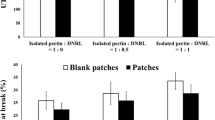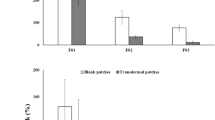Abstract
Many natural polymers with various chemical structures are used to prepare transdermal patches. Pectin is a one interesting type of polymer because it can control drug release when used in transdermal patches. In Thailand, the waste from durian fruit-hulls is a major problem for the environment. However, the pectin from it can be isolated under acid conditions and used to prepare transdermal patches for nicotine delivery which has not yet been reported. As the isolated pectin is a natural polymer, the film made from isolated pectin is a brittle; therefore, adding a low protein natural rubber latex (LPNRL) polymer was needed to increase its flexibility. The transdermal patches were amorphous and had Tg values ranging from 81.0 to 93.3 °C. Moisture uptake, swelling ratio, and erosion values of the patches were significantly decreased after addition of LPNRL, which resulted in low hydrophilicity. The in vitro release and permeation of nicotine depends on the hydrophilicity of the patches. The kinetic models for in vitro release and permeation of nicotine were Higuchi model and zero order, respectively. In conclusion, pectin isolated from fruit-hulls of Mon Thong durians is an effective polymer to control the release of nicotine. It also is an option that could solve the environmental problems caused by durian fruit-hulls waste.




Similar content being viewed by others
References
Furer V, Hersch M, Silvetzki N, Breuer GS, Zevin S (2010) Nicotiana glauca (tree tobacco) intoxication—Two cases in one family. J Med Toxicol 7:47–51
Abu-Huwaij R, Obaidat R, Sweidan K, Al-Hiari Y (2011) Formulation and in vitro evaluation of xanthan gum or carbopol 934-based mucoadhesive patches, loaded with nicotine. AAPS PharmSciTech 12:21–27
Dome P, Lazary J, Kalapos MP, Rihmer Z (2010) Smoking, nicotine and neuropsychiatric disorders. Neurosci Biobehav Rev 34:295–342
Gilbert SG (2004) Nicotine. Informa Healthcare, New York
Po ALW (1993) Transdermal nicotine in smoking cessation. Eur J Clin Pharmacol 45:519–528
Wang F-J, Yang Y-Y, Zhang X-Z, Zhu X, Chung T-S, Moochhala S (2002) Cellulose acetate membranes for transdermal delivery of scopolamine base. Mater Sci Eng C 20:93–100
Wokovich AM, Prodduturi S, Doub WH, Hussain AS, Buhse LF (2006) Transdermal drug delivery system (TDDS) adhesion as a critical safety, efficacy and quality attribute. Eur J Pharm Biopharm 64:1–8
Davidson A, Al-Qallaf B, Das DB (2008) Transdermal drug delivery by coated microneedles: geometry effects on effective skin thickness and drug permeability. Chem Eng Res Des 86:1196–1206
Pichayakorn W, Suksaeree J, Boonme P, Amnuaikit T, Taweepreda W, Ritthidej CG (2013) Deproteinized natural rubber film forming polymeric solutions for nicotine transdermal delivery. Pharm Dev Technol 18:1111–1121
Pichayakorn W, Suksaeree J, Boonme P, Taweepreda W, Amnuaikit T, Ritthidej GC (2015) Transdermal nicotine mixed natural rubber-hydroxypropylmethylcellulose film forming systems for smoking cessation: in vitro evaluations. Pharm Dev Technol 20:966–975
Pongjanyakul T, Khunawattanakul W, Puttipipatkhachorn S (2009) Physicochemical characterizations and release studies of nicotine–magnesium aluminum silicate complexes. Appl Clay Sci 44:242–250
Pichayakorn W, Suksaeree J, Boonme P, Amnuaikit T, Taweepreda W, Ritthidej GC (2012) Deproteinized natural rubber latex/hydroxypropylmethyl cellulose blending polymers for nicotine matrix films. Ind Eng Chem Res 51:8442–8452
Pichayakorn W, Suksaeree J, Boonme P, Amnuaikit T, Taweepreda W, Ritthidej GC (2012) Nicotine transdermal patches using polymeric natural rubber as the matrix controlling system: effect of polymer and plasticizer blends. J Membr Sci 411–412:81–90
Pichayakorn W, Suksaeree J, Boonme P, Amnuaikit T, Taweepreda W, Ritthidej GC (2012) Deproteinized natural rubber as membrane controlling layer in reservoir type nicotine transdermal patches. Chem Eng Res Des 91:520–529
Hokputsa S, Gerddit W, Pongsamart S, Inngjerdingen K, Heinze T, Koschella A et al (2004) Water-soluble polysaccharides with pharmaceutical importance from Durian rinds (Durio zibethinus Murr.): isolation, fractionation, characterisation and bioactivity. Carbohydr Polym 56:471–481
Thairath News (2016) https://www.thairath.co.th/content/967390
Khedari J, Charoenvai S, Hirunlabh J (2003) New insulating particleboards from durian peel and coconut coir. Build Environ 38:435–441
Lipipun V, Nantawanit N, Pongsamart S (2002) Antimicrobial activity (in vitro) of polysaccharide gel from durian fruit-hulls. Songklanakarin J Sci Technol 24:31–38
Pongsamart S, Nanatawanit N, Lertchaipon J, Lipipun V (eds) (2005) Novel water soluble antibacterial dressing of durian polysaccharide gel. In: Proceeding of III WOCMAP congress on medicinal and aromatic plants, 2005. Thailand, International Society for Horticultural Science (ISHS), Leuven, Belgium
Pongsamart S, Panmaung T (1998) Isolation of polysaccharides from fruit-hulls of durian (Durio zebethinus L.). Songklanakarin J Sci Technol 20:323–332
Anuradha K, Padma PN, Venkateshwar S, Reddy G (2010) Fungal isolates from natural pectic substrates for polygalacturonase and multienzyme production. Indian J Microbiol 50:339–344
Kohli P, Gupta R (2015) Alkaline pectinases: a review. Biocatal Agric Biotechnol 4:279–285
Pichayakorn W, Suksaeree J, Boonme P, Taweepreda W, Ritthidej GC (2012) Preparation of deproteinized natural rubber latex and properties of films formed by itself and several adhesive polymer blends. Ind Eng Chem Res 51:13393–13404
Yapo BM (2009) Biochemical characteristics and gelling capacity of pectin from yellow passion fruit rind as affected by acid extractant nature. J Agric Food Chem 57:1572–1578
Liang R-h, Chen J, Liu W, Liu C-m, Yu W, Yuan M et al (2012) Extraction, characterization and spontaneous gel-forming property of pectin from creeping fig (Ficus pumila Linn.) seeds. Carbohydr Polym 87:76–83
Cornelia M, Siratantri T, Prawita R (2015) The utilization of extract durian (Durio zibethinus L.) seed gum as an emulsifier in vegan mayonnaise. Proc Food Sci 3:1–18
Wai WW, Alkarkhi AFM, Easa AM (2009) Optimization of pectin extraction from durian rind (Durio zibethinus) using response surface methodology. J Food Sci 74:C637–C641
Chansiripornchai P, Pramatwinai C, Rungsipipat A, Ponsamart S, Nakchat O (eds) (2005) The efficiency of polysaccharide gel extracted from fruit-hulls of durian (Durio zibethinus L.) for wound healing in pig skin. In: Proceeding of III WOCMAP congress on medicinal and aromatic plants, 2005. Thailand, International Society for Horticultural Science (ISHS), Leuven, Belgium
Pichayakorn W, Suksaeree J, Taweepreda W (2014) Improved deproteinization process for protein-free natural rubber latex. Adv Mater Res 844:474–477
Suksaeree J, Pichayakorn W, Monton C, Sakunpak A, Chusut T, Saingam W (2014) Rubber polymers for transdermal drug delivery systems. Ind Eng Chem Res 53:507–513
Suksaeree J, Boonme P, Taweepreda W, Ritthidej GC, Pichayakorn W (2012) Characterization, in vitro release and permeation studies of nicotine transdermal patches prepared from deproteinized natural rubber latex blends. Chem Eng Res Des 90:906–914
Suksaeree J, Charoenchai L, Monton C, Chusut T, Sakunpak A, Pichayakorn W et al (2013) Preparation of a pseudolatex-membrane for ketoprofen transdermal drug delivery systems. Ind Eng Chem Res 52:15847–15854
Barros NRd, Chagas PAM, Borges FA, Gemeinder JLP, Miranda MCR, Garms BC et al (2015) Diclofenac potassium transdermal patches using natural rubber latex biomembranes as carrier. J Mater 1–7
Rippel MM, Lee L-T, Leite CAP, Galembeck F (2003) Skim and cream natural rubber particles: colloidal properties, coalescence and film formation. J Colloid Interface Sci 268:330–340
Roberts AD (1998) Natural rubber chemistry and technology. Oxford University Press, Oxford
Basu S, Shivhare US, Muley S (2013) Moisture adsorption isotherms and glass transition temperature of pectin. J Food Sci Technol 50:585–589
Isralowitz R (2015) Drug use: a reference handbook. ABC-CLIO, Santa Barbara
Siepmann J, Peppas NA (2001) Modeling of drug release from delivery systems based on hydroxypropyl methylcellulose (HPMC). Adv Drug Delivery Rev 48:139–157
Limpongsa E, Umprayn K (2008) Preparation and evaluation of diltiazem hydrochloride diffusion-controlled transdermal delivery system. AAPS PharmSciTech 9:464–470
Cherukuri S, Batchu UR, Mandava K, Cherukuri V, Ganapuram KR (2017) Formulation and evaluation of transdermal drug delivery of topiramate. Int J Pharm Investig 7:10–17
Baviskar DT, Parik VB, Gupta HN, Maniyar AH, Jain DK (2012) Design and evaluation of patches for transdermal delivery of losartan potassium. PDA J Pharm Sci Technol 66:126–135
Acknowledgements
The authors would like to acknowledge the Faculty of Pharmacy and the Research Institute of Rangsit University for their financial support (Grant No. 3/2560). The authors would like to express their gratitude to KI Tull, for her editing and assistance in the English language for this paper.
Author information
Authors and Affiliations
Corresponding author
Ethics declarations
Conflict of interest
The authors declare that they have no conflicts of interest.
Rights and permissions
About this article
Cite this article
Suksaeree, J., Karnsopa, P., Wannaphruek, N. et al. Transdermal Delivery of Nicotine Using Pectin Isolated from Durian Fruit-Hulls-Based Polymer Blends as a Matrix Layer. J Polym Environ 26, 3216–3225 (2018). https://doi.org/10.1007/s10924-018-1203-x
Published:
Issue Date:
DOI: https://doi.org/10.1007/s10924-018-1203-x




